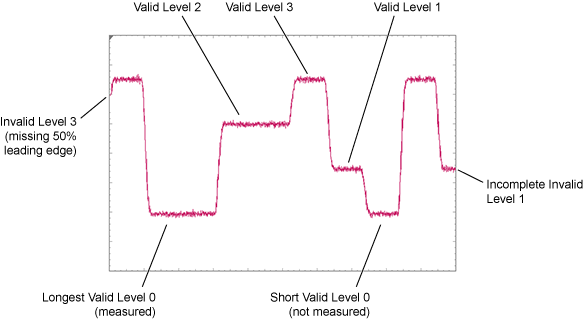:MEASure:OSCilloscope:PAM:LEVel
Command Syntax
:MEASure:OSCilloscope:PAM:LEVel
Query Syntax
:MEASure:OSCilloscope:PAM:LEVel?
Description
 In Oscilloscope mode, measures all four amplitude levels (0, 1, 2, 3) of a PAM4 signal. The signal must be displayed as a single-valued waveform. On NRZ signals, this measurement will measure the zero or one levels. Before sending this command, select the actual level to be measured using the
In Oscilloscope mode, measures all four amplitude levels (0, 1, 2, 3) of a PAM4 signal. The signal must be displayed as a single-valued waveform. On NRZ signals, this measurement will measure the zero or one levels. Before sending this command, select the actual level to be measured using the :LEVel child command. To measure all the levels on a signal, you must send this command once for each level as there is no command for simultaneously measuring all levels. The query form of the command returns the measured value. Sources can be any displayed PAM4 or NRZ waveform from a channel, differential channel, color-grade memory, or function. For example, CHAN1A, CGMemory1, or FUNCtion1.
The PAM4 waveform must be displayed as a single-valued waveform. To accomplish this, turn pattern lock on using the :TRIGger:PLOCk command (requires instrument Option ETR).
The amplitude of the selected level is calculated by:
- Identify one of each of the longest four logic levels on a PAM4 signal or two levels on an NRZ signal.
- Determine the longest of each of the four levels and measure the level at the center 12.5% (1/8) of individual symbols.
- Calculate the mean amplitude level over each identified interval.
Setting the Timespan in Oscilloscope Mode
You must set FlexDCA's timespan wide enough so that each logic level is visible on the screen. This would be four levels (0, 1, 2, 3) for a PAM4 signal or two levels (0, 1) for an NRZ signal. Failure to set the timespan wide enough results in an error. Consider the following items when setting the timespan:
- If multiple identical levels are displayed, the level that is present for the longest time will be selected for measurement. For example, if two logic levels are shown on the waveform, with one being 100 ps and the other being 150 ps, the 150 ps level is selected to be measured.
- To be considered a measureable level, the level must include at least 50% of the leading and trailing edges.

| Command | Equivalent Setting in PAM-N Analysis Setup Dialog |
Description |
|---|---|---|
:MEASure:PAM:AMPLitude:UNITs
|
Amplitude Units | Sets the amplitude units for measurement. |
Requires FlexDCA revision A.04.50 and above.
Measurement Identification
Avoid subtle programming errors! To ensure that the correct measurement is installed or queried, always explicitly identify a measurement when installing a measurement or querying a measured value, status, or detail. To identify a measurement, specify the measurement's source waveform (:SOURce child command). With some measurements, you may also need to specify other identifying values. Generally, when selecting a measurement using FlexDCA's GUI, if a dialog appears prompting you to select values, you should explicitly specify these values when remotely identifying the measurement. More information.
For example, to return the status of the measurement, :MEASure:OSCilloscope:PAM:LEVel:
flex.write(':MEASure:OSCilloscope:PAM:LEVel:SOURce CHAN1A')
if flex.query(':MEASure:OSCilloscope:PAM:LEVel:STATus?') == 'CORR';
measurement = flex.query(':MEASure:OSCilloscope:PAM:LEVel?')
else:
details = flex.query(':MEASure:OSCilloscope:PAM:LEVel:STATus:DETails?')
reason = flex.query(':MEASure:OSCilloscope:PAM:LEVel:STATus:REASon?')
Child commands for measurement identification:
:MEASure:OSCilloscope:PAM:LEVel:SOURce:MEASure:OSCilloscope:PAM:LEVel:REGion
Example Command Sequence
:SYSTem:MODE OSCilloscope :CHAN1A:SIGNal:TYPE:AUTO OFF // Specify signal type. :CHAN1A:SIGNal:TYPE PAM4 :TRIGger:PLOCk ON // Turn pattern lock on. :SYSTem:AUToscale :MEASure:OSCilloscope:PAM:LEVel:SOURce CHAN1A :MEASure:OSCilloscope:PAM:LEVel:LEVel LEVel3 // Select logic level to be measured. :MEASure:OSCilloscope:PAM:LEVel :MEASure:OSCilloscope:PAM:LEVel? // Return measured value.